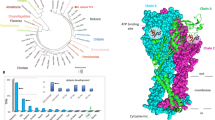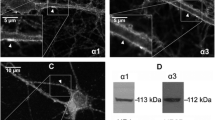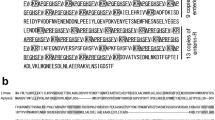Abstract
This paper presents a comparative study of the roles of Cl− and HCO3 − in the functioning of the GABAAR-associated Cl−/HCO3 −-ATPase of the plasma membranes of the olfactory sensory neurons (OSNs) and mature brain neurons (MBNs) of fish. The ATPase activity of OSNs and its dephosphorylation were increased twofold by Cl−(15–30 mmol l−1), whereas the enzyme from MBNs was not significantly affected by Cl−. By contrast, HCO3 −(15–30 mmol l−1) significantly activated the MBN enzyme and its dephosphorylation, but had no effect on the OSN ATPase. The maximum ATPase activity and protein dephosphorylation was observed in the presence of both Cl−(15 mmol l−1)/HCO3 −(27 mmol l−1) and these activities were inhibited in the presence of picrotoxin (100 μmol l−1), bumetanide (150 μmol l−1), and DIDS (1000 μmol l−1). SDS-PAGE revealed that ATPases purified from the neuronal membrane have a subunit with molecular mass of ~ 56 kDa that binds [3H]muscimol and [3H]flunitrazepam. Direct phosphorylation of the enzymes in the presence of ATP-γ-32P and Mg2+, as well as Cl−/HCO3 − sensitive dephosphorylation, is also associated with this 56 kDa peptide. Both preparations also showed one subunit with molecular mass 56 kDa that was immunoreactive with GABAAR β3 subunit. The use of a fluorescent dye for Cl− demonstrated that HCO3 −(27 mmol l−1) causes a twofold increase in Cl− influx into proteoliposomes containing reconstituted ATPases from MBNs, but HCO3 − had no effect on the reconstituted enzyme from OSNs. These data are the first to demonstrate a differential effect of Cl− and HCO3 − in the regulation of the Cl−/HCO3 −-ATPases functioning in neurons with different specializations.




Similar content being viewed by others
Abbreviations
- OSNs:
-
olfactory sensory neurons
- BNs:
-
brain neurons
- MBNs:
-
mature brain neurons
- IMNs:
-
immature neuron
- GABAAR:
-
GABAA receptor
- EM :
-
membrane potential
- ECl − :
-
equilibrium potential for Cl−
- [Cl−]i :
-
the intracellular concentration of Cl−
- CССs:
-
cation-chloride co-transporters
- KCCs:
-
K+/Cl− co-transporters
- NKCCs:
-
Na+/K+/2Cl− co-transporters
- AEs:
-
anion exchangers
- Picr:
-
picrotoxin
- Bum:
-
bumetanide
- Fur:
-
furosemide
- DIDS:
-
Disodium 4,4′-diisothiocyanatostilbene-2,2′-disulfonate
- VO4 2− :
-
o-vanadate
- MOPS:
-
3-(N-morpholino)propanesulfonic acid
- PVDF:
-
polyvinylidene difluoride (PVDF) membranes
- TBST:
-
tris-buffered saline
References
Alvarez-Leefmans FJ, Delpire E (2009) Physiology and pathology of chloride transporters and channels in the nervous system: from molecules to diseases. Elsevier-Academic Press, San Diego
Ben-Ari Y (2014) The GABA excitatory/inhibitory developmental sequence: a personal journey. Neuroscience 279:187–219. https://doi.org/10.1016/j.neuroscience.2014.08.001
Bettendorff L, Lakaye B, Margineanu I, Grisar T, Wins P (2002) ATP-driven, Na+-independent inward Cl−-pumping in neuroblastoma cells. J Neurochem 81(4):792–801. https://doi.org/10.1046/j.1471-4159.2002.00858.x
Bormann J, Hamill OP, Sakmann B (1987) Mechanism of anion permeation through channels gated by glycine and γ-aminobutyric acid in mouse cultured spinal neurones. J Physiol Lond 385(1):243–286. https://doi.org/10.1113/jphysiol.1987.sp016493
Bradford MM (1976) Rapid and sensitive method for the quantitation of microgram quantities of protein utilizing the principle of protein-dye binding. Anal Biochem 72(1-2):248–254. https://doi.org/10.1016/0003-2697(76)90527-3
Bureau MH, Laschet JJ (1995) Endogenous phosphorylation of distinct gamma-aminobutyric acid type A receptor polypeptides by Ser/Thr and Tyr kinase activities associated with the purified receptor. J Biol Chem 270(44):26482–26487. https://doi.org/10.1074/jbc.270.44.26482
Chen PS, Toribara TY, Warner H (1956) Microdetermination of phosphorus. Anal Chem 28(11):1756–1758. https://doi.org/10.1021/ac60119a033
Chub N, Mentis GZ, O'donovan MJ (2006) Chloride-sensitive MEQ fluorescence in chick embryo motoneurons following manipulations of chloride and during spontaneous network activity. J Neurophysiol 95(1):323–330. https://doi.org/10.1152/jn.00162.2005
Deisz RA, Lehmann TN, Horn P, Dehnicke C, Nitsch R (1996) Components of neuronal chloride transport in rat and human neocortex. J Physiol 589:1317–1347
Deng L, Nielsen M, Olsen RW (1991) Pharmacological and biochemical-properties of the gamma-aminobutyric acid/benzodiazepine receptor protein from codfish brain. J Neurochem 56(3):968–977. https://doi.org/10.1111/j.1471-4159.1991.tb02016.x
Dunn SMJ, Shelman RA, Agey MW (1989) Fluorescence measurements of anion transport by the GABAA receptor in reconstituted membrane preparations. Biochemistry 28(6):2551–2557. https://doi.org/10.1021/bi00432a031
Fatima-Shad K, Barry PH (1993) Anion permeation in GABA- and glycine-gated channels of mammalian cultured hippocampal neurons. Proc Biol Sci 253(1336):69–75. https://doi.org/10.1098/rspb.1993.0083
Friedl W, Hebebrand J, Rabe S, Propping P (1988) Phylogenetic conservation of the benzodiazepine binding sites: pharmacological evidence. Neuropharmacology 27(2):163–170. https://doi.org/10.1016/0028-3908(88)90166-9
Gerencser GA (1999) Cl−-ATPases: novel primary active transporters in animals. Zool Sci 16(4):571–577. https://doi.org/10.2108/zsj.16.571
Gerencser GA, Zelezna B (1993) Reaction sequence and molecular mass of a Cl−-translocating P-type ATPase. Proc Natl Acad Sci U S A 90(17):7970–7974. https://doi.org/10.1073/pnas.90.17.7970
Gerencser GA, Purushotham KR, Meng HB (1996) An electrogenic chloride pump in a zoological membrane. J Exp Zool 275(4):256–261. https://doi.org/10.1002/(SICI)1097-010X(19960701)275:4<256::AID-JEZ2>3.0.CO;2-O
Giraldez F, Murray KJ, Sepúlveda FV, Sheppard DN (1989) Characterization of a phosphorylation- activated Cl−-selective channel in isolated Necturus enterocytes. J Physiol 416(1):517–537. https://doi.org/10.1113/jphysiol.1989.sp017775
Halm DR, Frizzell RA (1992) Anion permeation in an apical membrane chloride channel of a secretory epithelial cell. J Gen Physiol 99(3):339–366. https://doi.org/10.1085/jgp.99.3.339
Hamilton TJ, Holcombe A, Tresguerres M (2014) CO2-induced ocean acidification increases anxiety in rockfish via alteration of GABAA receptor functioning. Proc R Soc B 281:1–7
Hebebrand J, Friedl W, Breidenbach B, Propping P (1987) Phylogenetic comparison of the photoaffinity-labeled benzodiazcpine receptor subunits. Neurochem 48(4):1103–1108. https://doi.org/10.1111/j.1471-4159.1987.tb05633.x
Inagaki C, Hara M, Zeng XT (1996) A Cl−-pump in rat-brain neurons. J Еxp Zool 275(4):262–268. https://doi.org/10.1002/(SICI)1097-010X(19960701)275:4<262::AID-JEZ3>3.0.CO;2-N
Isomura Y, Sugimoto M, Fujiwara-Tsukamoto Y, Yamamoto-Muraki S, Yamada J, Fukuda A (2003) Synaptically activated Cl−-accumulation responsible for depolarizing GABAergic responses in mature hippocampal neurons. J Neurophysiol 90(4):2752–2756. https://doi.org/10.1152/jn.00142.2003
Jechlinger M, Pelz R, Tretter V, Klausberger T, Sieghart W (1998) Subunit composition and quantitative importance of hetero-oligomeric receptors: GABAA receptors containing α6 subunits. J Neurosci 18(7):2449–2457
Kahle KT, Staley KJ (2008) The bumetanide-sensitive Na+-K+-2Cl− cotransporter NKCC1 as a potential target of a novel mechanism-based treatment strategy for neonatal seizures. Neurosurg Focus 25(3):E22. https://doi.org/10.3171/FOC/2008/25/9/E22
Kaila K, Price TJ, Payne JA, Puskarjov M, Voipio J (2014) Cation-chloride cotransporters in neuronal development, plasticity and disease. Nat Rev Neurosci 15(10):637–654. https://doi.org/10.1038/nrn3819
Kaneko H, Putzier I, Frings S, Kaupp UB, Gensch T (2004) Chloride accumulation in mammalian olfactory sensory neurons. J Neurosci 24(36):7931–7938. https://doi.org/10.1523/JNEUROSCI.2115-04.2004
Kermen F, Franco LM, Wyatt C, Yaksi E (2013) Neural circuits mediating olfactory-driven behavior in fish. Front Neural Circuits 7:1–9
Kirkness EF, Bovenkerk CF, Ueda T, Turner AJ (1989) Phosphorylation of gamma-aminobutyrate (GABA)/benzodiazepine receptors by cyclic AMP-dependent protein kinase. Biochem J 259(2):613–616. https://doi.org/10.1042/bj2590613
Laemmli UK (1970) Cleavage of structural proteins during the assembly of the head of bacteriophage. Nature 227(5259):680–685. https://doi.org/10.1038/227680a0
Leduc AO, Munday PL, Brown GE, Ferrari MC (2013) Effects of acidification on olfactory-mediated behaviour in freshwater and marine ecosystems: a synthesis. Philos Trans R Soc B 368(1627):20120447. https://doi.org/10.1098/rstb.2012.0447
Lo MM, Snyder SH (1983) Two distinct solubilized benzodiazepine receptors: differential modulation by ions. J Neurosci 3(11):2270–2279
Menzikov SA (2013) Neuronal multifunctional ATPase. Biophys Rev Lett 8(03n04):213–227. https://doi.org/10.1142/S1793048013300065
Menzikov SA (2016) Isolation, purification, and partial characterization of a membrane-bound Cl-/HCO3 --activated ATPase complex from rat brain with sensitivity to GABAAergic ligands. Prep Biochem Biotechnol 47(2):151–157. https://doi.org/10.1080/10826068.2016.1188312
Menzikov SA, Menzikova OV (2002a) Interaction of pentobarbital with GABAAergic drugs acting on the Cl−-ATPase activity of the plasma membranes from bream brain (Abramis brama L.) Neurosci Lett 334(3):161–164. https://doi.org/10.1016/S0304-3940(02)01076-5
Menzikov SA, Menzikova OV (2002b) Effects of orthovanadate and genistein on the plasma membrane Cl−-ATPase sensitive to GABA-ergic ligands in the bream (Abramis brama L.) brain. Dokl Biol Sci 385(1/6):334–336. https://doi.org/10.1023/A:1019952515746
Menzikov SA, Menzikova OV (2007) Effects of GABAAergic ligands on Cl−-transport induced by the Cl−, HCO3 −-ATPase from carp (Cyprinus carpio L.) brain reconstituted in proteoliposomes. Neurochem J 1(1):31–36. https://doi.org/10.1134/S1819712407010047
Menzikov SA, Karpova MN, Kalinina MV (2011) Effect of HCO3 − ions on the ATP-dependent GABAA receptor-coupled Cl−-channel in rat brain plasma membranes. Bull Exp Biol Med 152(1):38–42. https://doi.org/10.1007/s10517-011-1448-z
Menzikov S, Karpova M, Kuznetsova L, Klishina N (2015) GABAA-Coupled Cl-/HCO3 --ATPase from plasma membrane of the rat brain: role of HCO3 - in the enzyme activation. Adv Enzym Res 3(01):9–18. https://doi.org/10.4236/aer.2015.31002
Nickell WT, Kleene NK, Kleene SJ (2007) Mechanisms of neuronal chloride accumulation in intact mouse olfactory epithelium. J Physiol 583(3):1005–1020. https://doi.org/10.1113/jphysiol.2007.129601
Pedersen PL (2005) Transport ATPases: structure, motors, mechanism and medicine. J Bioenerg Biomembr 37(6):349–357. https://doi.org/10.1007/s10863-005-9470-3
Perkins KL, Wong RKS (1996) Ionic basis of the postsynaptic depolarizing GABA response in hippocampal pyramidal cells. J Neurophysiol 76(6):3886–3894
Reisert J, Lai J, Yau K-W, Bradley J (2005) Mechanism of the excitatory Cl− response in mouse olfactory receptor neurons. Neuron 45(4):553–561. https://doi.org/10.1016/j.neuron.2005.01.012
Rivera C, Voipio J, Kaila K (2005) Two developmental switches in GABAergic signalling: the K+-Cl−-cotransporter KCC2 and carbonic anhydrase CAVII. J Physiol 562(1):27–36. https://doi.org/10.1113/jphysiol.2004.077495
Roy B, Ali DW (2014) Multiple types of GABAA responses identified from zebrafish Mauthner cells. Neuroreport 25(15):1232–1236. https://doi.org/10.1097/WNR.0000000000000258
Ruffin VA, Salameh AI, Boron WF, Parker MD (2014) Intracellular pH regulation by acid-base transporters in mammalian neurons. Front Physiol 5:32–43
Staley KJ, Proctor WR (1999) Modulation of mammalian dendritic GABAA receptor function by the kinetics of Cl− and HCO3 − transpоrt. J Physiol Lond 519(3):693–712. https://doi.org/10.1111/j.1469-7793.1999.0693n.x
Takagi SF, Wyse GA, Toshi Y (1966) Anion permeability of the olfactory receptive membrane. J Gen Physiol 50(2):473–489. https://doi.org/10.1085/jgp.50.2.473
Vithlani M, Terunuma M, Moss SJ (2011) The dynamic modulation of GABAA receptor trafficking and its role in regulating the plasticity of inhibitory synapses. Physiol Rev 91(3):1009–1022. https://doi.org/10.1152/physrev.00015.2010
Watanabe M, Fukuda A (2015) Development and regulation of chloride homeostasis in the central nervous system. Front Cell Neurosci 9:1–14
Watson GB, Salgado VL (2001) Maintenance of GABA receptor function of small-diameter cockroach neurons by adenine nucleotides. Insect Biochem Mol Biol 31:207–212
Wilkinson M, Wilkinson DA, Khan I, Crim LW (1983) Benzodiazepine receptors in fish brain: [3H]-flunitrazepam binding and modulatory effects of GABA in rainbow trout. Brain Res Bull 10(3):301–303. https://doi.org/10.1016/0361-9230(83)90094-1
Zhainazarov AB, Wachowiak M, Boettcher A, Elenes S, Ache BW (1997) Ionotropic GABA receptor from lobster olfactory projection neurons. J Neurophysiol 77(5):2235–2251
Author information
Authors and Affiliations
Corresponding author
Ethics declarations
The experimental investigations of the material was approved by the Ethical Committee of FSBSI “Institute of general pathology and pathophysiology” (No 01-01/147 from October 12, 2009) and performed according to the principles expressed in the Declaration of Helsinki revised by WMA, Fortaleza, Brazil, 2013.
Rights and permissions
About this article
Cite this article
Menzikov, S. Biochemical properties of the sensitivity to GABAAergic ligands, Cl−/HCO3 −-ATPase isolated from fish (Cyprinus carpio) olfactory mucosa and brain. Fish Physiol Biochem 44, 583–597 (2018). https://doi.org/10.1007/s10695-017-0455-z
Received:
Accepted:
Published:
Issue Date:
DOI: https://doi.org/10.1007/s10695-017-0455-z




